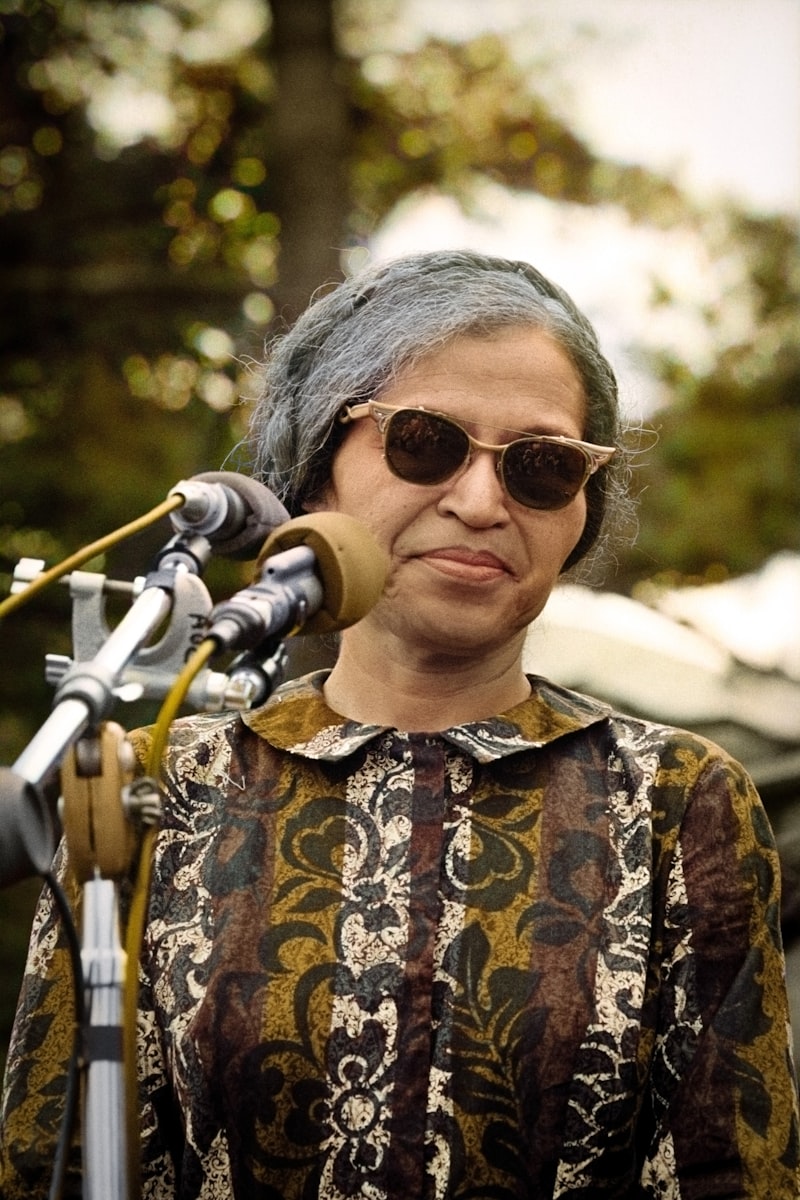Malcolm X, on the other hand, advocated for self-defense and empowerment within the African American community. His uncompromising stance on racial pride and equality resonated with many who felt disillusioned with the slow progress of nonviolent protest. Malcolm X’s fiery oratory skills and his role in the Nation of Islam brought attention to systemic racism and the need for more radical action.
Another key figure was Rosa Parks, whose defiance in refusing to give up her bus seat to a white passenger sparked the Montgomery Bus Boycott. Her quiet courage symbolized the everyday resistance against segregation and inspired countless others to challenge discriminatory laws and practices.
Additionally, leaders like Ella Baker focused on grassroots organizing and empowering local communities. As a prominent organizer within the Southern Christian Leadership Conference (SCLC) and later in the Student Nonviolent Coordinating Committee (SNCC), Baker emphasized the importance of collective action and long-term community engagement.
These leaders, through their diverse strategies ranging from nonviolent direct action to community organizing and self-defense, collectively pushed the boundaries of social justice and paved the way for significant legislative changes, such as the Civil Rights Act of 1964 and the Voting Rights Act of 1965. Their approaches varied, yet all aimed at dismantling segregation and achieving equality under the law, leaving an indelible mark on American history.
Unveiling the Key Figures: Leaders Who Defined the Civil Rights Movement
When we think about the Civil Rights Movement, names like Martin Luther King Jr., Rosa Parks, and Malcolm X often come to mind. These leaders were not just historical figures but pivotal forces that reshaped the course of American history. Their courage, determination, and unwavering commitment to justice continue to inspire generations.
Martin Luther King Jr., a Baptist minister and activist, is perhaps the most iconic figure of the Civil Rights Movement. His leadership during the Montgomery Bus Boycott and his famous “I Have a Dream” speech underscored his belief in nonviolent protest as a powerful force for change. King’s ability to articulate the aspirations of millions cemented his legacy as a symbol of hope and equality.
Rosa Parks, often called the “mother of the Civil Rights Movement,” became an enduring symbol of resistance when she refused to give up her seat on a segregated bus in Montgomery, Alabama. Her act of defiance sparked the Montgomery Bus Boycott and brought international attention to the issue of racial segregation in the United States.
Malcolm X, known for his advocacy of Black nationalism and self-defense, provided a stark contrast to King’s philosophy of nonviolence. His outspokenness and critique of systemic racism challenged both black and white Americans to confront the realities of racial injustice. Malcolm X’s evolution from a Nation of Islam leader to a more inclusive worldview continues to influence discussions on race and identity.
Beyond these prominent figures, the Civil Rights Movement saw countless others who played crucial roles. Ella Baker, an activist and organizer, emphasized grassroots organizing and empowered ordinary people to take leadership roles in their communities. Thurgood Marshall, a lawyer who later became the first African American Supreme Court Justice, tirelessly fought against segregation in courts across the country.
Each of these leaders brought a unique perspective and strategy to the fight for civil rights. Their collective efforts not only led to landmark legislative achievements like the Civil Rights Act of 1964 and the Voting Rights Act of 1965 but also paved the way for ongoing struggles for social justice today.
Understanding the contributions of these key figures is essential to appreciating the complexity and diversity of the Civil Rights Movement. Their stories remind us that change is possible when individuals are willing to stand up against injustice, no matter the odds.
Behind the Scenes: Strategies That Shaped the Civil Rights Era
The Civil Rights Era stands as a pivotal moment in American history, defined by courageous actions and strategic movements that reshaped society. While iconic leaders like Martin Luther King Jr. and Rosa Parks are widely recognized, the era’s success was also driven by lesser-known strategies that played critical roles behind the scenes.
One such strategy was grassroots organizing, which empowered local communities to mobilize for change. Activists worked tirelessly, from organizing voter registration drives in the South to staging sit-ins at segregated lunch counters. These actions were not only protests but also strategic moves to challenge unjust laws and social norms.
Legal strategies were another cornerstone of the Civil Rights Movement. Organizations like the NAACP strategically pursued legal battles that would challenge segregation laws in courts across the country. Landmark cases such as Brown v. Board of Education of Topeka marked significant victories that dismantled the legal framework of segregation.
Media played a crucial role in shaping public opinion and garnering support for the movement. Television broadcasts and newspapers brought images of peaceful protesters facing violent opposition into homes across America. These visuals sparked national conversations and pushed lawmakers to take action.
Economic boycotts emerged as powerful tools to pressure businesses and institutions to end discriminatory practices. The Montgomery Bus Boycott, sparked by Rosa Parks’ refusal to give up her seat, lasted over a year and demonstrated the economic impact of collective action.
Trailblazers of Equality: Leaders and Tactics in the Civil Rights Struggle

Martin Luther King Jr., with his stirring oratory and unwavering commitment to nonviolent resistance, emerged as a beacon of hope during one of America’s darkest hours. His famous “I Have a Dream” speech reverberated across the nation, igniting hearts and minds with its powerful vision of a harmonious, integrated society.
Alongside King stood Rosa Parks, whose simple act of defiance sparked the Montgomery Bus Boycott and became a touchstone for the struggle against segregation. Her refusal to give up her seat to a white man was not just a solitary act of defiance but a catalyst that galvanized a community and inspired a movement.
The tactics employed by these leaders were as strategic as they were revolutionary. Nonviolent protest became a hallmark of the civil rights movement, challenging the status quo without resorting to violence. Sit-ins, marches, and boycotts were not just protests; they were acts of resistance that demanded attention and catalyzed change.
The civil rights struggle wasn’t confined to the streets of America’s cities. Leaders like Malcolm X advocated for Black empowerment and self-defense, challenging the narrative of passive resistance with a call for assertiveness and self-determination. His message resonated with many who felt disenfranchised by the slow progress of integration.
As the movement gained momentum, legislative victories like the Civil Rights Act of 1964 and the Voting Rights Act of 1965 marked significant milestones in the fight for equality. These legislative triumphs were a testament to the power of grassroots activism and political mobilization, illustrating how determined individuals could reshape the fabric of a nation.
Leadership Icons of the Civil Rights Era and Their Impactful Strategies
Martin Luther King Jr., renowned for his impassioned speeches and commitment to nonviolent resistance, galvanized millions with his powerful rhetoric. His “I Have a Dream” speech remains an enduring symbol of hope and equality, urging Americans to judge individuals not by the color of their skin but by the content of their character.
Rosa Parks, often called the “mother of the civil rights movement,” ignited a wave of protest by refusing to give up her bus seat to a white passenger in Montgomery, Alabama. Her act of defiance sparked the Montgomery Bus Boycott, a pivotal event that showcased the power of collective action and peaceful protest in confronting segregation.
Malcolm X, a vocal advocate for black empowerment, challenged mainstream civil rights strategies with his unapologetic stance against racism and calls for self-defense. His fiery speeches and advocacy for black pride resonated deeply within marginalized communities, emphasizing the importance of self-respect and cultural identity.
Each leader brought a unique perspective to the fight for civil rights, emphasizing the importance of strategy, unity, and resilience in the face of adversity. Their actions not only challenged systemic racism but also inspired generations to continue the struggle for equality and justice.
Today, their legacies endure as reminders of the power of leadership and the enduring impact of individuals who dare to challenge injustice. Their strategies, whether through nonviolent protest, legal advocacy, or community mobilization, continue to influence movements around the world, reaffirming the timeless importance of standing up for what is right and just.
Strategic Brilliance: How Civil Rights Leaders Orchestrated Change
At the heart of this strategic brilliance was the ability to harness the power of unity. Leaders like Martin Luther King Jr. and Rosa Parks understood that true strength lay in solidarity, rallying individuals from diverse backgrounds under a singular cause. They transcended personal fears and societal pressures to stand as beacons of hope, challenging the status quo with courage and conviction.
Strategic brilliance also manifested in the tactical deployment of nonviolent resistance. Mahatma Gandhi’s philosophy of Satyagraha, embraced by civil rights leaders, wielded the force of truth against the machinery of oppression. Through acts of civil disobedience and peaceful protests, they confronted injustice head-on, compelling the world to confront its moral contradictions.
Moreover, these leaders exhibited an unparalleled ability to leverage media and public opinion. By strategically choosing moments and methods of protest, they catalyzed national and international awareness. The Montgomery Bus Boycott, led by Rosa Parks, and the March on Washington, spearheaded by Martin Luther King Jr., became watershed moments that galvanized global support for the civil rights cause.
Their strategic brilliance extended beyond immediate gains to long-term impact. They laid the groundwork for legislative change, influencing policymakers to enact laws that dismantled institutionalized discrimination. The Civil Rights Act of 1964 and the Voting Rights Act of 1965 stand as testament to their enduring legacy, reshaping the fabric of American society.
In essence, the story of civil rights leaders is a testament to the power of strategic brilliance in effecting transformative change. Through unity, nonviolent resistance, media savvy, and legislative influence, they shattered barriers and paved the way for a more just and equitable world. Their legacy serves as a timeless reminder of what can be achieved through vision, courage, and unwavering commitment to justice.
Profiles in Courage: Influential Figures of the Civil Rights Movement
The Civil Rights Movement of the 1950s and 1960s in the United States stands as a testament to the power of courage and perseverance in the face of adversity. Many iconic figures emerged during this pivotal time, each making significant contributions to the fight against racial discrimination and segregation.
One of the most recognized leaders of the Civil Rights Movement was Martin Luther King Jr. His impassioned speeches, including the famous “I Have a Dream” speech, stirred the hearts of millions and galvanized support for desegregation and equality. King’s nonviolent approach inspired peaceful protests and civil disobedience across the nation, leaving an indelible mark on American history.
Rosa Parks, often referred to as the “Mother of the Civil Rights Movement,” sparked a pivotal moment when she refused to give up her bus seat to a white passenger in Montgomery, Alabama. Her act of defiance led to the Montgomery Bus Boycott, a year-long protest against segregation on public buses that ultimately ended in a Supreme Court ruling declaring such segregation unconstitutional.
Another key figure, Malcolm X, advocated for black empowerment and self-defense in the face of violent racism. His advocacy for black nationalism and criticism of nonviolent protest contrasted with Martin Luther King Jr.’s approach but added depth to the movement’s strategies and goals.
John Lewis, a prominent civil rights leader and later a U.S. Congressman, played a crucial role in organizing peaceful protests and voter registration drives. He famously led the 1965 march across the Edmund Pettus Bridge in Selma, Alabama, which became known as Bloody Sunday due to the violent police response against the peaceful demonstrators.
These influential figures, among many others, sacrificed their safety and comfort to fight for justice and equality. Their courage and determination paved the way for significant legislative changes, including the Civil Rights Act of 1964 and the Voting Rights Act of 1965, which dismantled legal segregation and ensured voting rights for African Americans.
The legacy of these courageous individuals continues to inspire generations to stand up against injustice and advocate for equality in all aspects of society. Their stories remind us that ordinary people, through extraordinary acts of bravery and conviction, can bring about monumental change and make the world a better place for future generations.
Tactical Innovations: Strategies That Redefined Civil Rights Activism
One pivotal innovation is the strategic use of nonviolent resistance, exemplified by figures like Martin Luther King Jr. and Mahatma Gandhi. This approach harnesses moral authority and media attention, amplifying the message of justice and equality. By reframing protests as acts of courage rather than aggression, these leaders galvanized public support and pressured policymakers to enact reforms.
In the digital age, social media has emerged as a transformative tool for activism. Platforms like Twitter and Instagram enable rapid mobilization and global outreach, fostering solidarity among disparate communities. Campaigns such as #BlackLivesMatter and #MeToo have harnessed the viral nature of social media to spark conversations, challenge narratives, and hold institutions accountable.
Furthermore, intersectionality has enriched civil rights activism by acknowledging and addressing overlapping forms of discrimination. This approach recognizes that issues like race, gender, sexuality, and class intersect, shaping individuals’ experiences of oppression and privilege. Activists like Kimberlé Crenshaw have championed intersectionality, advocating for inclusive policies and amplifying marginalized voices.
Moreover, legal strategies have played a crucial role in advancing civil rights. Landmark court cases, such as Brown v. Board of Education and Obergefell v. Hodges, have dismantled institutionalized discrimination and expanded rights for marginalized groups. These legal victories have set precedents, paving the way for subsequent activism and legislative reforms.
Frequently Asked Questions
What strategies did Martin Luther King Jr. use to advance civil rights
Learn about the strategies Martin Luther King Jr. employed to advance civil rights, including nonviolent resistance, peaceful protests, civil disobedience, and effective communication through powerful speeches.
What were the contributions of Rosa Parks and what strategies did she employ
Learn about Rosa Parks’ contributions to the civil rights movement and the strategies she employed, including her pivotal role in sparking the Montgomery Bus Boycott by refusing to give up her seat, symbolizing resistance against racial segregation.
How did Malcolm X influence the Civil Rights Movement through his strategies
Learn how Malcolm X influenced the Civil Rights Movement through his strategic approaches and advocacy for self-defense and empowerment among African Americans.
Who were the key leaders of the Civil Rights Movement and what were their roles
Discover the key leaders of the Civil Rights Movement and their pivotal roles in shaping history. Learn about figures like Martin Luther King Jr., who advocated nonviolent resistance, and Rosa Parks, whose act of defiance sparked the Montgomery Bus Boycott. Explore their contributions to advancing equality and social justice in America.
How did nonviolent resistance shape the strategies of Civil Rights leaders
Discover how nonviolent resistance influenced Civil Rights leaders’ strategies, shaping peaceful protests and fostering unity amidst adversity.



